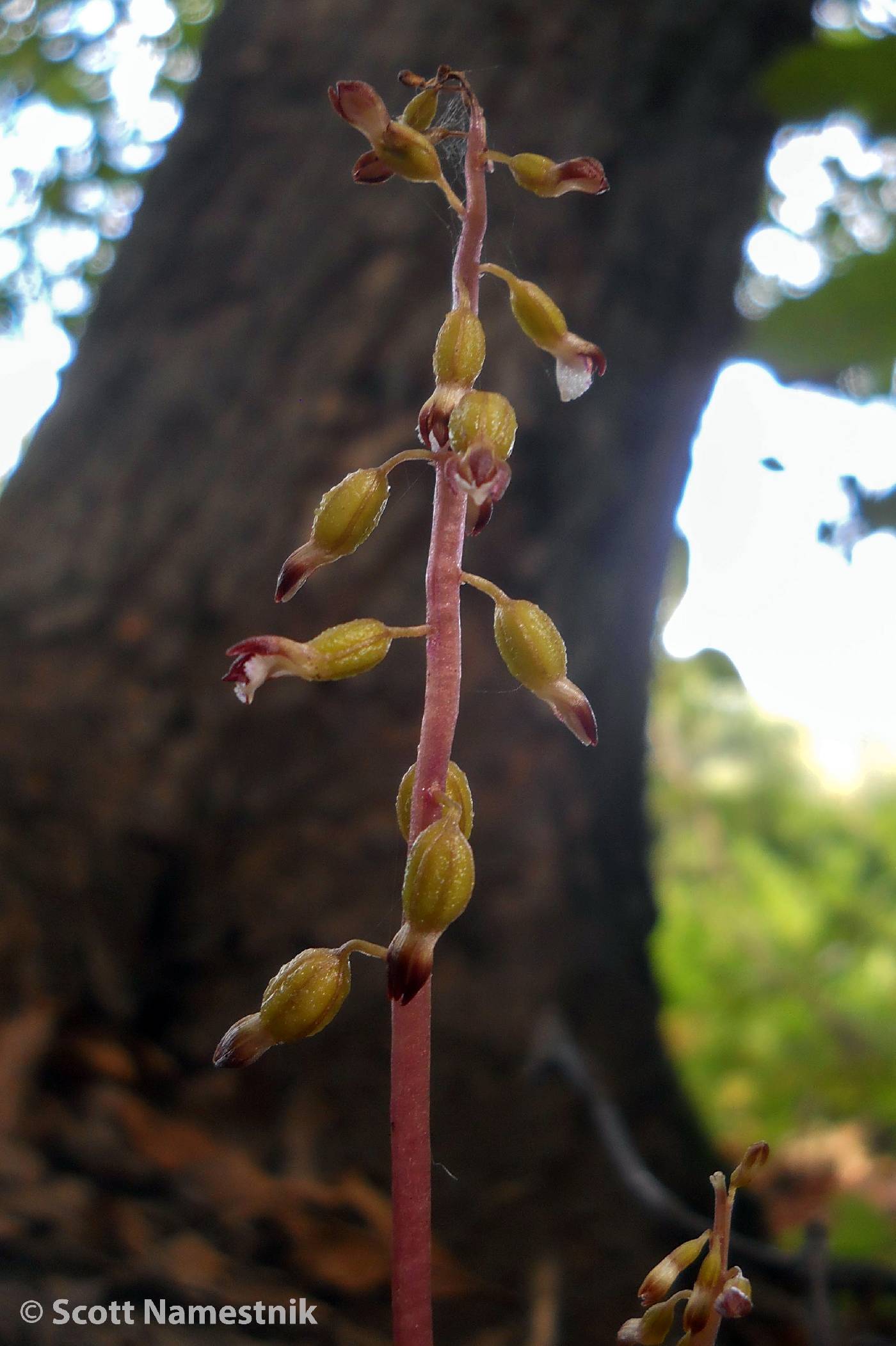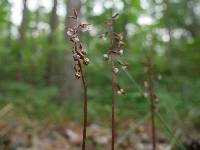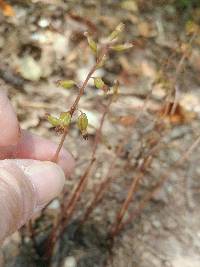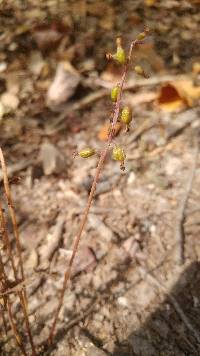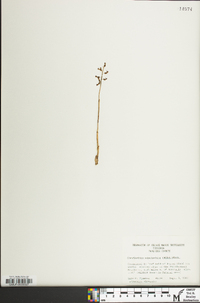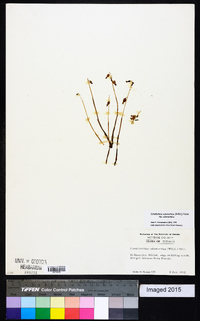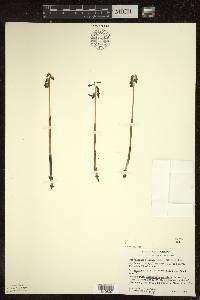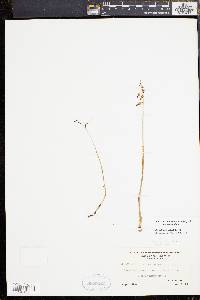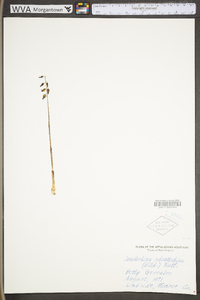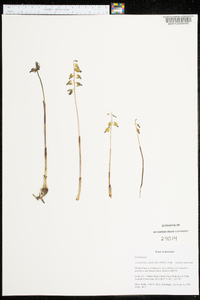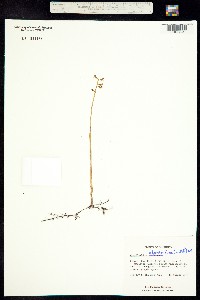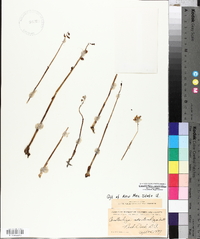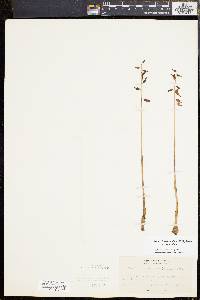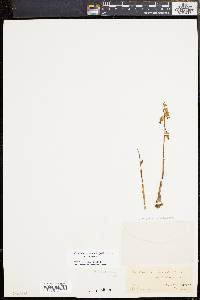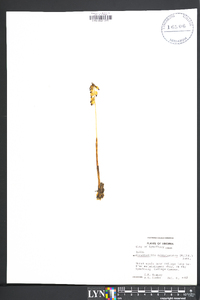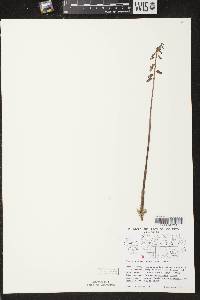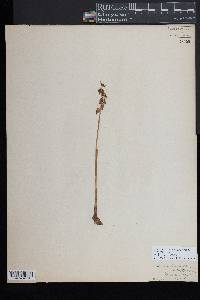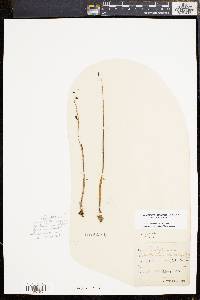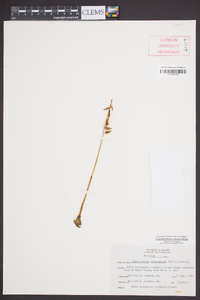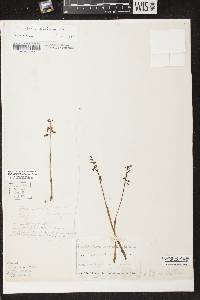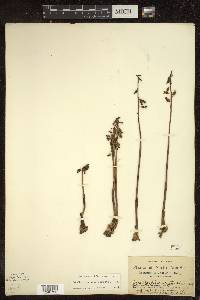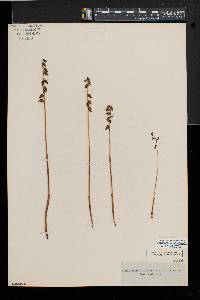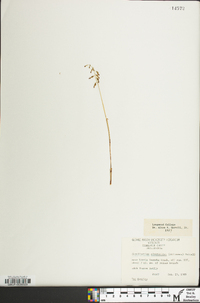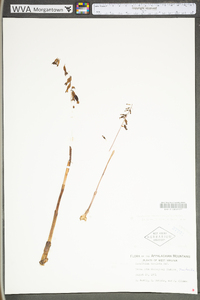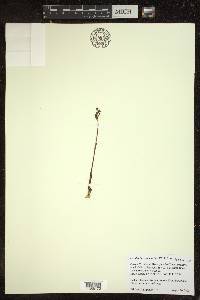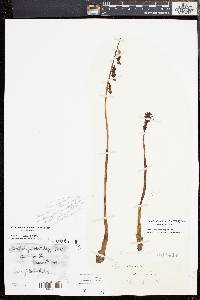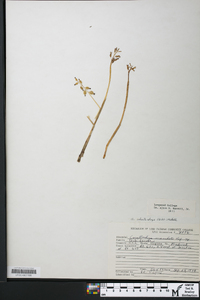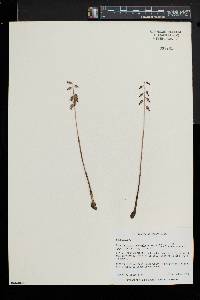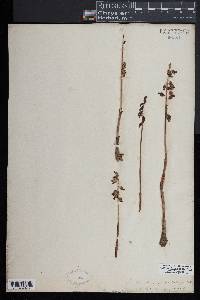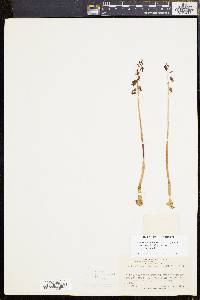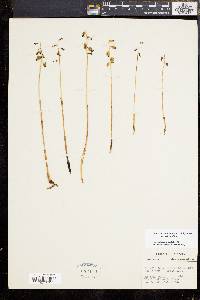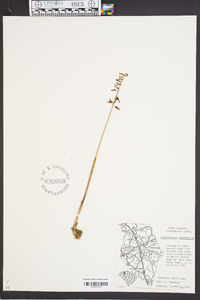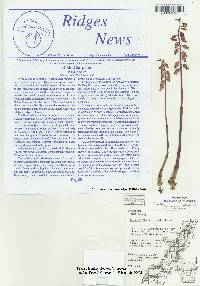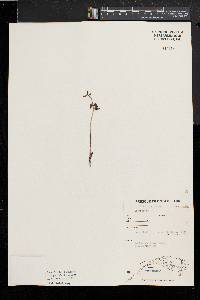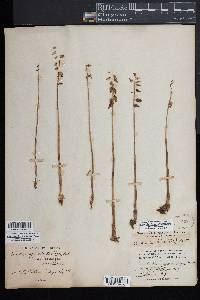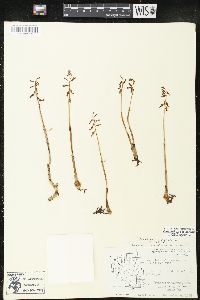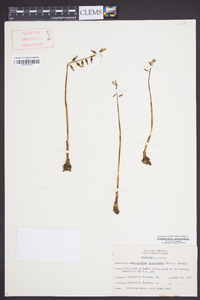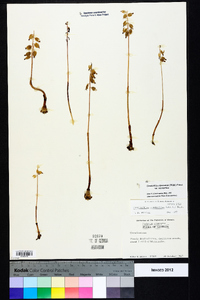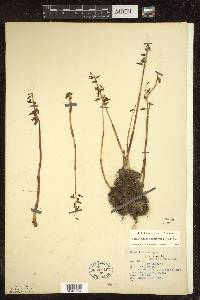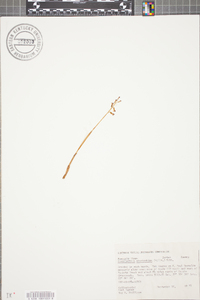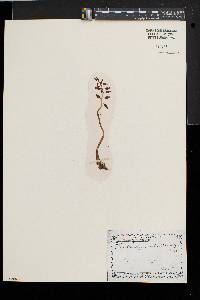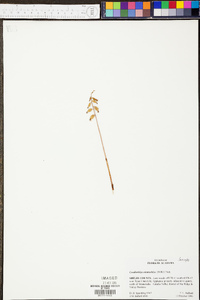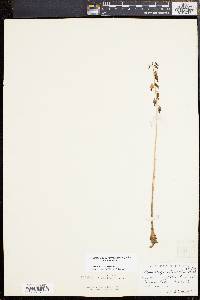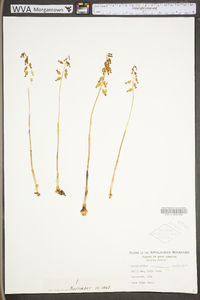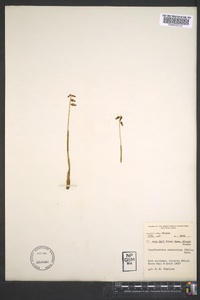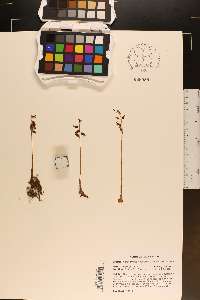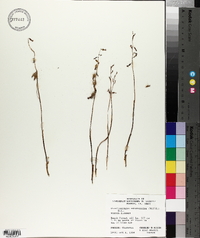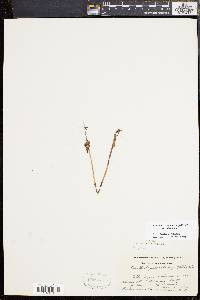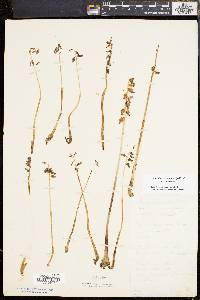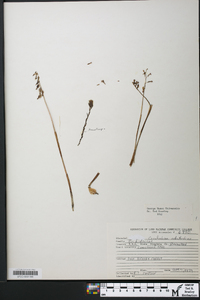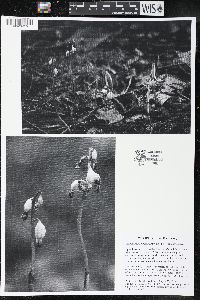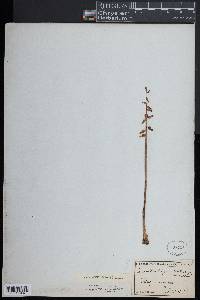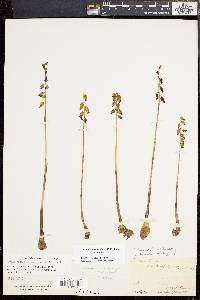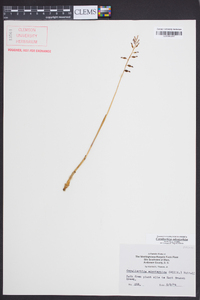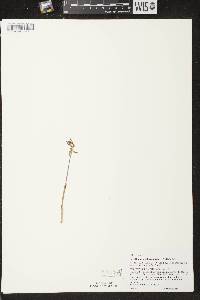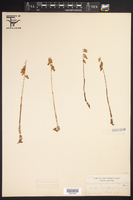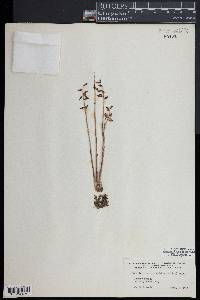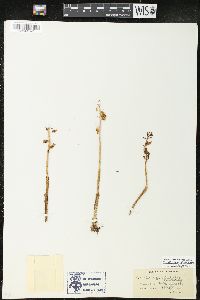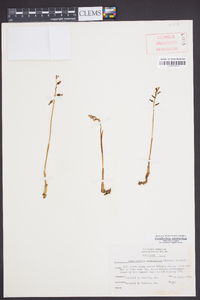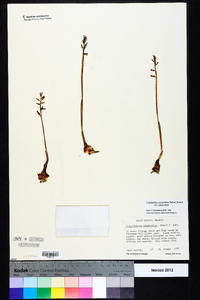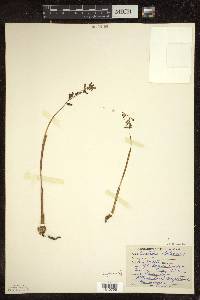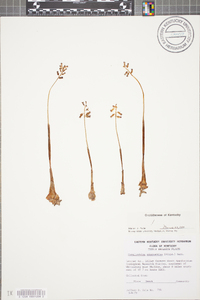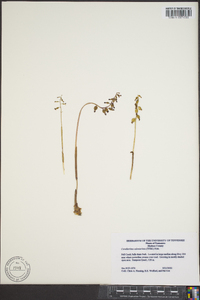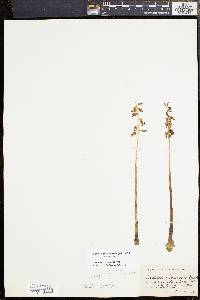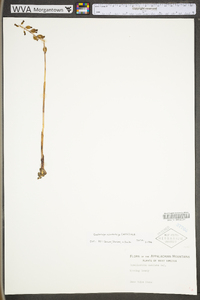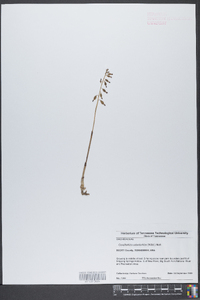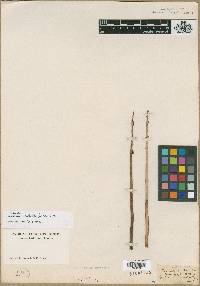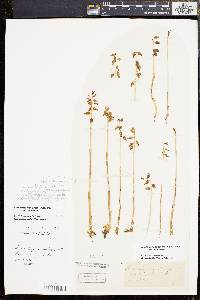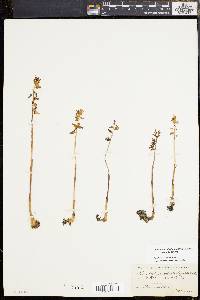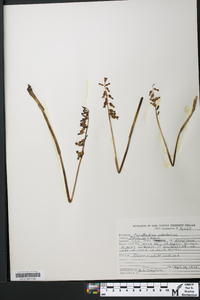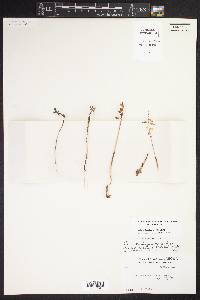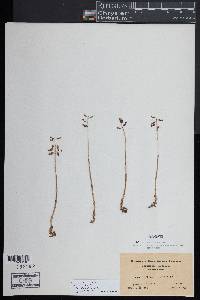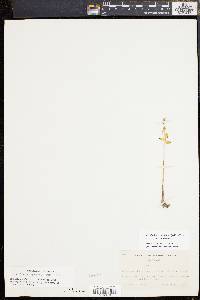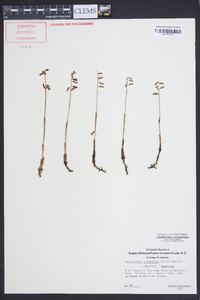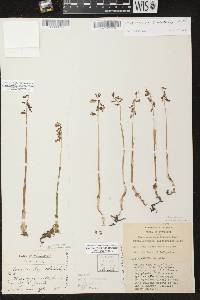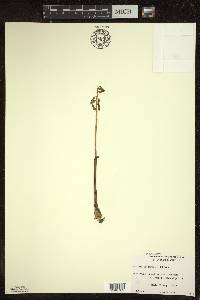Corallorhiza odontorhiza
|
|
|
|
Family: Orchidaceae
Autumn Coralroot, more...late coralroot
[Corallorrhiza odontorhiza Nutt., moreCymbidium odontorhizon Willd.] |
Stems yellow, greenish, or purplish brown, base strongly thickened, bulbous. Inflorescences: racemes lax, 11-46 × 1-2.5 cm. Flowers 5-26, inconspicuous; perianth open or closed; sepals and petals reddish purple to brown, often suffused with green, broadly lanceolate, 1-2-veined; lateral sepals strongly curved upward and directed forward, 3-4.5 mm; petals 2.5-3.8 mm, connivent with dorsal sepal to form hood over column, or sepals and petals connivent to produce closed flower; lip white, often spotted with purple, ovate to orbiculate-quadrangular, unlobed, 2.7-4.6 ×1.8-3.7 mm, thin, with 2 distinct basal lamellae, margins entire to erose-fringed; column white basally, often purple apically, 1.9-2.5 mm, straight or curved toward lip, with 2 distinct auricles in open-flowered plants; ovary 2.5-5 mm; mentum inconspicuous. Capsules broadly ellipsoid, 5.5-8 × 3.5-5 mm. Perennial mycotrophic (saprophytic) herb 10 - 40 cm tall Leaves: none. Inflorescence: a single, erect, terminal, long-stalked, loose, spike-like cluster of two to thirty, slender-stalked, inconspicuous flowers with each flower subtended by a minute bract. This rather short (usually under 25 cm tall) and narrow (1 - 2.5 cm wide) inflorescence often only produces cleistogamous flowers, that is flowers that remain closed, self-fertilize, and are quite fertile, however one variety does produce open flowers. Flowers: dark brownish purple to more reddish purple, small (3 - 5 mm long), often not opening, bilaterally symmetric, lacking a spur, but with sepals and petals grouped together and pointing forward to form a hood over lip petal. The reproductive parts of stamens, stigma and style are fused into a column above the 2.5 - 5 mm long, greatly swollen, inferior ovary. Sepals: three, forward-pointing, petal-like, dark purple-brown or reddish purple, with central sepal 3 - 4 mm long and 1 - 1.5 mm wide while lateral sepals somewhat narrower (about 1 mm wide) and a bit longer (3 - 5 mm long). The upper sepal has a single prominent lengthwise vein and is fairly lance-shaped with a blunt tip, but the lateral sepals are more linear. Petals: three, with upper two pointing forward and converging with upper sepal to form a hood over lip petal. The two lateral petals are 3 - 4 mm long, 1 mm wide, lance- to spoon-shaped, and greenish purple to brown. Lip white with purple to magenta streaks or spots, 2 - 4.6 mm long, 1.7 - 4.5 mm wide, unlobed, rounded to oval or more egg-shaped with very narrow base, and one variety with fringe along tip. The main surface of the lip petal also has two divergent lengthwise ridges (lamellae) near the base. Fruit: several, stalked, nodding, 5.5 - 8 mm long, 3.5 - 5 mm wide, plump, rounded to ellipsoid capsules with remnant column at apex. Flowering stem: single, erect, strongly thickened and bulbous at base, hairless, fleshy, brownish to purple or yellow to greenish, lacking leaves, but with a few tubular sheaths. This leafless structure terminated by flowers is called a scape and technically is not a true stem. Root system: lacking true roots, but with multiple-branched, coral-like rhizome with swollen area meeting stem base. Column: straight or curved toward lip, white at base and often purple toward tip, 1.8 - 2.5 mm long, 0.8 - 1.7 mm wide, with 0.2 - 0.5 mm long and 0.3 - 1 mm wide stigma. Similar species: Corallorhiza odontorhiza is most similar to C. wisteriana, but that species has a larger central sepal (over 4.5 mm long) with three veins, and it flowers much earlier in the year (April to June). There are two varieties of C. odontorhiza, the most common being the typical C. odontorhiza var. odontorhiza with usually closed flowers, a narrower (1.7 - 2.5 mm wide) and slightly shorter (2 - 4 mm long) smooth-tipped lip, and a 1.9 - 2.5 mm long, 0.8 - 1 mm wide column with a smaller (0.2 - 0.4 mm long, 0.3 - 0.5 mm wide) stigmatic surface. Alternatively, C. odontorhiza var. pringlei usually has open flowers, the lip petal is wider and more rounded (2 - 3.7 mm wide, 2.7 - 4.6 mm long) with a fringed tip, and the column is shorter (1.8 - 2.4 mm long), broader (0.8 - 1.7 mm wide), and has a larger stigmatic surface (0.3 - 0.5 mm long, 0.7 - 1 mm wide). Flowering: mid-August to September Habitat and ecology: Occasional, in dry oak woods, successional beech woods, or wooded banks. It is very tolerant of disturbance, and occurs on both acidic and basic substrates. Occurence in the Chicago region: native Notes: In the typical variety of this species the closed flowers (cleistogamous) reproduce by self-pollination. These flowers are often pollinated before the inflorescence fully matures in size, which can be seen by the greatly swollen ovaries. Since these flowers have no need for pollinators, the flowers have no need to open. In the other variety however, the flowers do open and receive pollinators. The main range of this species is more southern and Appalachian. Etymology: Corallorhiza comes from the Greek words korallion, meaning coral, and rhiza, meaning root, in reference to the branching, underground rhizome, which has a similar appearance to coral. Odontorhiza means "toothed root" in reference to the tooth-like swelling of the stem base above the rhizome. Author: The Field Museum Stem 1-2 dm, with a bulbous-thickened white base, otherwise purple to brown, or greenish above; infl 3-6 cm; fls 5-15; sep and lateral pet extending forward over the column, oblong, 3-4.5 mm, yellowish to purplish-green or dark purple; lip declined, short-clawed or nearly sessile, expanded above into a rotund blade 3-4 mm, white, usually purple-margined with 2 purple spots, entire or finely erose, often emarginate. Open woods; Me. and Vt. to N.Y., s. Mich., and s. Minn., s. to Fla. and Mex. Aug.-Sept. Gleason, Henry A. & Cronquist, Arthur J. 1991. Manual of vascular plants of northeastern United States and adjacent Canada. lxxv + 910 pp. ©The New York Botanical Garden. All rights reserved. Used by permission. From Flora of Indiana (1940) by Charles C. Deam This species is found in slightly acid soil in bare places in fallow fields, or in rather sandy soil in deep humus in black and white oak woods. Very local in its distribution but probably found here and there throughout the state. It has been reported from other counties but wrong determinations are so frequent that to enumerate them might lead to confusion. |

